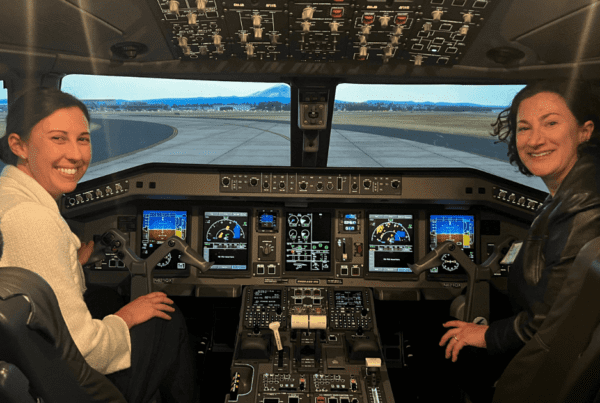The Department of Biomedical Informatics and Medical Education, UW School of Medicine, recently launched a new Division of Clinical Informatics; and at the same time in conjunction with the Department of Pediatrics, launched a new section of Pediatric Clinical Informatics. Michael Leu, MD, MS, MHS is the inaugural division head and section chief.
Dr. Leu is a professor in the Department of Pediatrics and the Department of Biomedical Informatics and Medical Education and the program director for the Accreditation Council for Graduate Medical Education (ACGME)-accredited Clinical Informatics Fellowship program. He has years of experience in computer science and software development.
Learn more about Dr. Leu, his goals for the new division and meet his newest four-legged family member.
Get to Know Him:
With years of experience in both software development/computer science and clinical medicine, how did you find yourself in these fields and when did they start to overlap for you?
I got my Bachelor’s and Master’s degrees in Computer Science at UW in 1985 and 1988, respectively. I started in the industry with a summer internship at Microsoft, which turned into a full-time position. About six years into the job, I discovered that I wanted to bring my technology skills into medicine, so I looked into many different programs. At that time, around 1994, hospitals were starting to think about making their medical records electronic. I asked, ‘What are you going to do with this information once it is on the computer?’ and the answers were not encouraging. That’s where I first saw the need for experts in both technology and in medicine. I thought if I studied medicine, I might better understand the problems that technology can help solve.
I was outstanding at math and science in school, however medicine is an entirely different kind of training. It was a very humbling experience for me to go to medical school. I did five years at the UW School of Medicine, graduating with Thesis Honors. My introduction to using technology to try and affect patient outcomes was my MD thesis research under the mentorship of Drs. Tom Norris and Peter Tarczy-Hornoch using two-way pagers with automated reminders to support patients with diabetes. We were able to show that using technology helped patients feel like somebody cared about them. And it showed that this technology could help patients normalize their blood pressure.
The reason that informatics exists is that we have these two completely different disciplines — medicine and technology — that don’t speak a common vocabulary. When you talk to the doctors about what they’re trying to do, they often don’t really understand all the available technology options. And when you talk to the technologists, they’re building systems to solve problems, however, some of these problems may not really exist. Informatics allows us to apply the latest technology in ways that are going to move the needle and create change.
What are your clinical and research interests?
I was in the Rural Underserved Opportunities Program at the UW School of Medicine between my first and second year as a medical student, and also did rotations in rural spots in Washington, Idaho and Montana. I learned that it’s up to doctors to figure out how to keep their medical practice up to date — and that it’s also impossible to study and know everything. I wanted to find out how doctors working in rural towns can use technology to stay up to date and provide the same level of care as academic medical centers like UW Medicine or Seattle Children’s Hospital.
In 2007, Seattle Children’s hired me to work on solving that very problem. I worked on creating care standards for the first 10 or so years of my career, figuring out how to take the literature and turn it into evidence-based clinical recommendations as clinical decision support. That work is coming full circle, as the clinical informatics fellows are learning how to create guidelines and electronic tools to help doctors in their workflow. The generally accepted literature is that clinical standards take about 17 years to go into widespread practice – however, for monkeypox, we accelerated the creation and implementation of those standards so that doctors could practice the best known care within one month. One of the clinical informatics fellows recently conducted a systematic review of how we can use the electronic health record to support graduate medical education. One way is to collect the diagnoses and conditions that trainees have seen from the Electronic Heath Record, and to use that information to ensure they get a more well-rounded education. For example, if they have been seeing many patients with heart failure and none with monkeypox, we might assign them to the next patient with monkeypox cared for by their team to enhance their learning or ensure that they are taught about monkeypox through didactics. With this research, we are creating a vision for taking medical education to a higher level.
Why are the Department of Biomedical Informatics and Medical Education creating a new division, and the Department of Pediatrics creating a new section?
The new Division of Clinical Informatics and Section on Pediatric Clinical Informatics are collaborations between the Department of Biomedical Informatics and Medical Education, Seattle Children’s and the Department of Pediatrics at UW School of Medicine. The new division will support the need for an academic and intellectual home for faculty outside of Biomedical Informatics and Medical Education and engaged in clinical informatics scholarship. The establishment of these units is part of the Department of Biomedical Informatics and Medical Education’s broader strategic plan in the area of biomedical informatics scholarship and the translation of scholarship to the practice of biomedical informatics (specifically in this case in the subdomain of clinical informatics).
Clinical informatics is a relatively new medical specialty, and many new to the field don’t necessarily have mentors in their department with training in this field. We want this division to be a resource for people interested in this line of work to find community and mentorship so our colleagues can kick off their careers and have support for their scholarly activity. This division will be a place for colleagues to find support across departments, learn from one another, apply for grants together and encourage each other.
What is your vision as head of the division and section?
My Department chairs and I hope the division and section can serve as a home for people interested in clinical informatics to grow their skills and to collaborate. A place where we can take the ideas that we have and use them to transform medicine and to support our health system’s operational goals.
What is the ACGME-accredited Clinical Informatics Fellowship and how will it work within the division?
The Clinical Informatics Fellowship was ACGME-accredited in 2016, and there are now 58 fellowships across the country. It is a two-year fellowship open to anybody who has completed ACGME-accredited specialty or subspecialty training. Positions are funded by UW Medicine, plus a pediatric-track position is funded by Seattle Children’s Hospital. The key elements of the fellowship are:
- Three-month rotations in each of the following four areas —outpatient informatics, inpatient informatics, enterprise informatics (analytics, security, software development) and priority projects,
- A two-month elective,
- A master’s degree and final project in the Clinical Informatics and Patient Centered Technologies program (joint between the School of Nursing and BIME),
- A one-year small group curriculum covering evidence-based clinical pathway construction, the Toyota Production System, Improvement Science and machine learning,
- Continued clinical practice in the fellows’ primary medical specialty.
We have five fellows at any given time. It’s a two-year fellowship program that focuses on experiential learning. As a fellowship director, I encourage the fellows to work on projects and measure the outcomes of those projects to see their impact.
With a measurement-driven focus, we’ve demonstrated some pretty big wins coming out of our fellowship program and that our program has supported.
When we switched to Epic with Destination: One, our fellows worked on documentation improvement efforts. With their efforts, nursery notes went from taking about half an hour to write to less than ten minutes.
We even looked to see if people are still using the note-writing templates that we built or if they are building their own, and over ninety percent of people are using the note templates our fellows helped build in the system, which is unheard of.
That’s just one example of the type of powerful things we do with the fellowship program, and the division will be a place of support for the fellows during their time with us.
Anything else you would like employees to know about the new division?
If you are interested in informatics, I’m happy to talk. Please email me at mgl27@uw.edu. We’re looking for people that are interested in being a part of this new division. You don’t have to have any particular level of expertise; if you have an interest, we’re here to help.
Current Biomedical Informatics and Medical Education faculty in the Division of Biomedical and Health Informatics and the Division of Medical Education and Evaluation can join this new division by just asking. Other UW faculty outside of Biomedical Informatics and Medical Education engaged in clinical informatics scholarship will need to contact me, as there is a standard BIME application process for adjunct/affiliate faculty.
What do you love most about working for UW Medicine?
I went to UW School of Medicine for medical school and returned to UW Medicine in 2015 for a faculty appointment and to lead the fellowship program. One of the things I really like about UW Medicine is that when we come together (as informaticians, medical professionals, analysts and other stakeholders) and decide we want to do something, we not only make it happen but turn it into something world-class.
What are your hobbies outside of work?
Our youngest kids are just starting high school, our middle ones are in college at UW and our oldest is working in the software industry. We have an English Cream Golden Retriever who just turned fourteen months old that my wife Flora and I love taking on walks.

I’m really into watching our local sports teams — the Huskies, Mariners and Seahawks. I’ve also gotten into watching online chess and was pleased that the self-proclaimed chess streamer Hikaru Nakamura just became World Champion by winning the 2022 World Fischer Random Chess championship.


